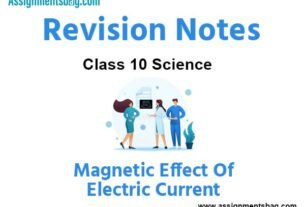Please see Control and Coordination Class 10 Science Revision Notes provided below. These revision notes have been prepared as per the latest syllabus and books for Class 10 Science issues by CBSE, NCERT, and KVS. Students should revise these notes for Chapter 7 Control and Coordination daily and also prior to examinations for understanding all topics and to get better marks in exams. We have provided Class 10 Science Notes for all chapters on our website.
Chapter 7 Control and Coordination Class 10 Science Revision Notes
INTRODUCTION
As the complexity of the individuals, plants or animals increases the different cells and organs become separated from each other by greater distance. Thus it becomes necessary to have a system by which the different parts of the organisms can function as a single unit. This is possible only if the different parts can coordinate with each other and carry out a particular function.
To carry out a simple function such as picking up an object from the ground there has to be coordination of the eyes, hands, legs and the vertebral column. The eyes have to focus on the object, the hands have to pick it up and grasp it, the legs have to bend and so does the back bone (vertebral column). All these actions have to be coordinated in such a manner that they follow a particular sequence and the action is completed. A similar mechanism is also needed for internal functions of the body.
The individuals also have to adjust to the changing conditions around them and vary their responses. At the same time, the internal cond itions of the body should be maintained constant. This is called homeostasis. Homeostasis is derived from ‘homeo’ meaning same and ‘stasis’ meaning standing still. The internal conditions of the body are maintained at a constant by controlling the physiology of the organism. Just as in animals, plants also have to control and coordinate their various functions.
NERVOUS SYSTEM
The nervous system of an animal is composed of
1. Specialized cells called neurons or nerve cells which can detect, receive and transmit different kinds of stimuli.
2. The nerve fibres which are certain bundles of extended processes of nerve cells.
NERVE CELLS
Nerve cells or neurons are the structural and functional units of the nervous system. Billions of nerve cells make up our brain.
A nerve cell is a microscopic structure consisting of three major parts namely cell body, dendrites and axon.
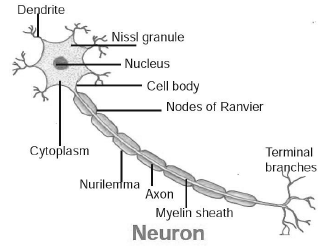
CELL BODY
It is the cell structure irregular in shape or polyhedral structure, it is also called as cyton. Cell body contains cytoplasm with typical cell organelles and certain granular bodies are called Nissl granules .
DENDRITES
Dendrites or Dendrons are shorter fibres which branch repeatedly and project out of the cell body. Dendrites transmit electrical impulses towards the cyton.
AXON
One of the fibres arising from the cell body is very long with a branched distal end and it is called as Axon.
The distal branches terminate as bulb like structures called synaptic knob filled with chemicals called neuro transmitters. Axon contains axoplasm inside and is covered by a membrane called neurilemma. Neurilemma encloses the axon except at the branched distal ends. In some neurons called myelinated neurons an additional white fatty fibre called myelin sheath covers the neurilemma. Myelin sheath is not continous over the neurilemma. The gaps left by the myelin sheath on the axon are called Nodes of Ranvier. Over the myelin sheath are found certain cells called Schwann cells.
TYPES OF NERVE CELLS
1. Myelinated or Medullated or White neurons: When the axon is enclosed by the white fatty myelin cover it is called Myelinated or Medullated or White neurons. This forms the cerebral cortex of our brain.
2. Non- Myelinated or Non-Medullated or Grey neurons: This neuron is not enclosed by myelin sheath; so it appears greyish in colour. The axon is covered by only neurilemma and Schwann cells. This type of neuron is found in the white matter of cerebrum.
3. Unipolar neurons: The embryonic nervous tissue contains unipolar neurons. An unipolar neuron has a nerve cell body with a single process or fibre, which will act both as axon and Dendron.
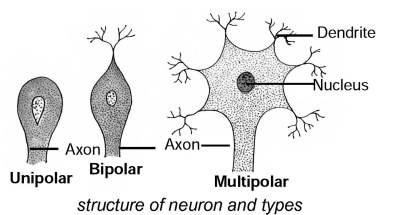
4.Bipolar neurons: The sensory hair cells of the sense organs like rods and cones of retina are made up of bipolar neurons. Each bipolar neuron has a cell body and two process at the ends, one acting as axon and the other acting as Dendron.
5. Multipolar neuron: The cerebral cortex contains the multipolar neurons; each multipolar neuron has a cell body with many dendrites and an axon.
Synapse: The dendrites and the synaptic knobs of the axons of neighbouring neurons are in physical contact with one another without fusing. This point of contact between the neighbouring nerve cells is called synapse.
NERVE IMPULSE
The conduction of stimuli by the nerve cells is called nerve impulse. The dendrites will receive the stimuli from the receptor (sense organ) and conduct the same as electrical impulse to the axon through the cyton. At the synapse, the synaptic knobs release out chemical substances called neuro transmitters which convert the electrical impulse into chemical impulse and pass it to the neighbouring neuron.
TYPES OF NEURON
1. Sensory neuron: These neurons receive signals from a sense organ.
2. Motor neuron: These neurons send signals to a muscle or a gland.
3. Association neuron: These neurons relay the signals between sensory neuron and motor neuron.
Pathways: From stimulus to response
In the holding stick activity you observed that there is coordination between eye and finger. Different pathways are taken by nerves to bring about this coordinated activity.
On the basis of pathways followed, nerves are classified mainly into three different types.
AFFERENT NEURONS:
Afferent (or ferrying towards) which carry messages towards the central nervous system (spinal cord or brain) from nerve endings on the muscles of different sense organs that sense the change in surroundings are called stimulus detectors. These are also called ‘sensory’ nerves.

EFFERENT NEURON:
Efferent (or ferrying away) which carry messages from the central nervous system to parts that shall carry out the response or the effectors (nerve endings). They are also called ‘motor’ nerves.

ASSOCIATION NERVES:
Association nerves, which link together the afferent and efferent nerves.

NERVOUS SYSTEM IN HUMANS
The nervous system can be divided into two major regions: the central and peripheral nervous systems. The central nervous system (CNS) is the brain and spinal cord, and the peripheral nervous system (PNS) is everything else. The brain is contained within the cranial cavity of the skull, and the spinal cord is contained within the vertebral cavity of the vertebral column. It is a bit of an oversimplification to say that the CNS is what is inside these two cavities and the peripheral nervous system is outside of them, but that is one way to start to think about it. In actuality, there are some elements of the peripheral nervous system that are within the cranial or vertebral cavities. The peripheral nervous system is so named because it is on the periphery—meaning beyond the brain and spinal cord. Depending on different aspects of the nervous system, the dividing line between central and peripheral is not necessarily universal.
The nervous system can be divided into two parts mostly on the basis of a functional difference in responses. The somatic nervous system (SNS) is responsible for conscious perception and voluntary motor responses. Voluntary motor response means the contraction of skeletal muscle, but those contractions are not always voluntary in the sense that you have to want to perform them. Some somatic motor responses are reflexes, and often happen without a conscious decision to perform them. If your friend jumps out from behind a corner and yells
“Boo!” you will be startled and you might scream or leap back. You didn’t decide to do that, and you may not have wanted to give your friend a reason to laugh at your expense, but it is a reflex involving skeletal muscle contractions. Other motor responses become automatic (in other words, unconscious) as a person learns motor skills (referred to as “habit learning” or “procedural memory”).
The autonomic nervous system (ANS) is responsible for involuntary control of the body, usually for the sake of homeostasis (regulation of the internal environment). Sensory input for
autonomic functions can be from sensory structures tuned to external or internal environmental stimuli. The motor output extends to smooth and cardiac muscle as well as glandular tissue. The role of the autonomic system is to regulate the organ systems of the body, which usually means to control homeostasis. Sweat glands, for example, are controlled by the autonomic system. When you are hot, sweating helps cool your body down. That is a homeostatic mechanism. But when you are nervous, you might start sweating also. That is not homeostatic, it is the physiological response to an emotional state.
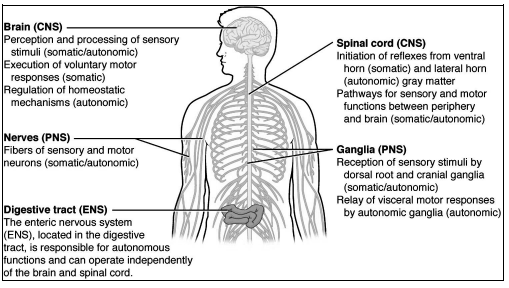
There is another division of the nervous system that describes functional responses. The enteric nervous system (ENS) is responsible for controlling the smooth muscle and glandular tissue in your digestive system. It is a large part of the PNS, and is not dependent on the CNS. It is sometimes valid, however, to consider the enteric system to be a part of the autonomic system because the neural structures that make up the enteric system are a component of the autonomic output that regulates digestion. There are some differences between the two, but for our purposes here there will be a good bit of overlap. See Figure for examples of where these divisions of the nervous system can be found.
REFLEX ACTION
Reflex action is a special case of involuntary movement in voluntary organs. When a voluntary organ is in the vicinity of a sudden danger, it is immediately pulled away from the danger to save itself. For example; when your hand touches a very hot electric iron, you move away your hand in a jerk. All of this happens in flash and your hand is saved from the imminent injury. This is an example of reflex action.

Reflex Arc: The path through which nerves signals; involved in a reflex action; travel is called the reflex arc. The following flow chart shows the flow of signal in a reflex arc.

The receptor is the organ which comes in the danger zone. The sensory neurons pick signals from the receptor and send them to the relay neuron. The relay neuron is present in the spinal cord. The spinal cord sends signals to the effector via the motor neuron. The effector comes in action moves the receptor away from the danger.
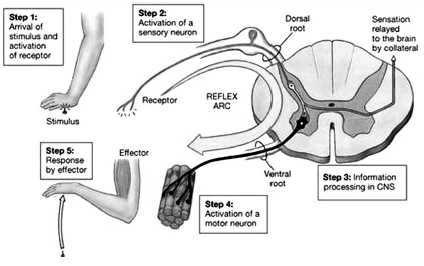
The reflex arc passes at the level of the spinal cord and the signals involved in reflex action do not travel up to the brain. This is important because sending signals to the brain would involve more time. Although every action is ultimately controlled by the brain, the reflex action is mainly controlled at the level of spinal cord.
Muscular Movements and Nervous Control: Muscle tissues have special filaments; called actin and myosin. When a muscle receives a nerve signal; a series of events is triggered in the muscle. Calcium ions enter the muscle cells. It results in actin and myosin filaments sliding towards each other and that is how a muscle contracts. Contraction in a muscle brings movement in the related organ.
HUMAN BRAIN
Human brain is a highly complex organ; which is mainly composed of the nervous tissue. The tissues are highly folded to accommodate a larger surface area in less space. The brain is covered by a three layered system of membranes; called meninges. Cerebrospinal fluid is filled between the meninges. The CSF provides cushion to the brain against mechanical shocks.
Furthermore, the brain is housed inside the skull for optimum protection. The human brain can be divided into three regions, viz. forebrain, midbrain and hindbrain.
PARTS OF HUMAN BRAIN
- Forebrain: It is composed of the cerebrum.
- Midbrain: It is composed of the hypothalamus.
- Hindbrain: It is composed of the cerebellum, pons and medulla oblongata.
Some main structures of the human brain are explained below.
Cerebrum: The cerebrum is the largest part in the human brain. It is divided into two hemispheres; called cerebral hemispheres.
FUNCTIONS OF CEREBRUM:
- The cerebrum controls the voluntary motor actions.
- It is the site of sensory perceptions; like tactile and auditory perceptions.
- It is the seat of learning and memory.
Hypothalamus: The hypothalamus lies at the base of the cerebrum. It controls sleep and wake cycle (circadian rhythm) of the body. It also controls the urges for eating and drinking.
Cerebellum: Cerebellum lies below the cerebrum and at the back of the whole structure. It coordinates the motor functions. When you are riding your bicycle; the perfect coordination between your pedaling and steering control is achieved by the cerebellum.
Medulla: Medulla forms the brain stem; along with the pons. It lies at the base of the brain and continues into the spinal cord. Medulla controls various involuntary functions; like hear beat, respiration, etc.
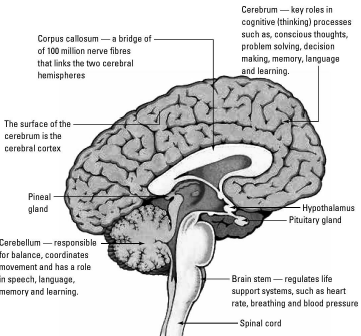
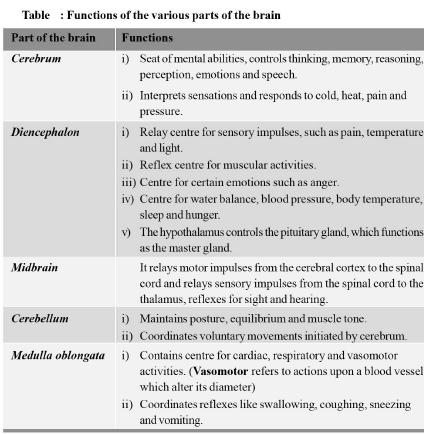
Question. What is the difference between a reflex action and walking?
Answer: A reflex action is a rapid, automatic response to a stimulus. It does not involve any thinking. For example, we close our eyes immediately when the bright light is focused. Walking, on the other hand, is a voluntary action. It is under our conscious control.
Question. What happens at the synapse between two neurons?
Answer: A very small gap that occurs between the last portion of axon of one neuron and the dendron of the other neuron is known as a synapse. It acts as a one way valve to transmit impulses in one direction only. This uni-direction transfer of impulses occurs as the chemicals are produced in only one side of the neuron i.e., the axon’s side. From axon, the impulses travel across the synapse to the dendron of the other neuron.
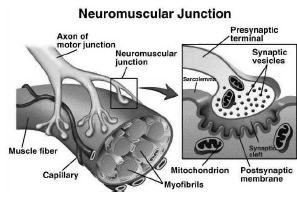
Question. Which part of the brain maintains posture and equilibrium of the body?
Answer: Cerebellum, a part of hindbrain is responsible for maintaining posture and equilibrium of the body.
Question. How do we detect the smell of an agarbatti (incense stick)?
Answer: The thinking part of our brain is the forebrain. It has separate areas that are specialized for hearing , smelling, sight, taste, touch, etc. The forebrain also has regions that collect information or impulses from the various receptors. When the smell of an incense stick reaches us, our forebrain detects it. Then, the forebrain interprets it by putting it together with the information received from other receptors and also with the information already stored in the brain.
Question. What is the role of the brain in reflex action?
Answer: Reflex actions are sudden responses, which do not involve any thinking. For example, when we touch a hot object, we withdraw our hand immediately without thinking as thinking may take time which would be enough to get us burnt.
The sensory nerves that detect the heat are connected to the nerves that move the muscles of the hand. Such a connection of detecting the signal from the nerves (input) and responding to it quickly (output) is called a reflex arc. The reflex arcs −connections present between the input and output nerves − meet in a bundle in the spinal cord.

REFLEX ARC: Reflex arcs are formed in the spinal cord and the information (input) reaches the brain. The brain is only aware of the signal and the response that has taken place. However, the brain has no role to play in the creation of the response.
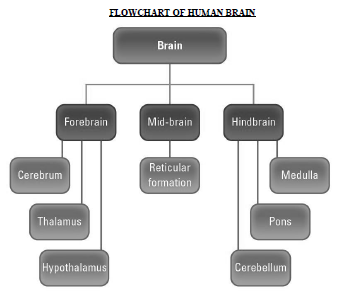
COORDINATION IN PLANTS:
Unlike animals, plants do not have a nervous system. Plants use chemical means for control and coordination. Many plant hormones are responsible for various kinds of movements in plants. Movements in plants can be divided into two main types, viz. tropic movement and nastic movement.
TROPIC MOVEMENT:
The movements which are in a particular direction in relation to the stimulus are called tropic movements. Tropic movements happen as a result of growth of a plant part in a particular direction. There are four types of tropic movements, viz. geotropic, phototropic, hydrotropic and thigmotropic.
- Geotropic Movement: The growth in a plant part in response to the gravity is called geotropic movement. Roots usually show positive geotropic movement, i.e. they grow in the direction of the gravity. Stems usually show negative geotropic movement.
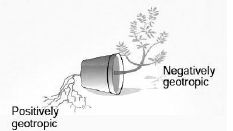
- Phototropic Movement: The growth in a plant part in response to light is called phototropic movement. Stems usually show positive phototropic movement, while roots usually show negative phototropic movement. If a plant is kept in a container in which no sunlight reaches and a hole in the container allows some sunlight; the stem finally grows in the direction of the sunlight. This happens because of a higher rate of cell division in the part of stem which is away from the sunlight. As a result, the stem bends towards the light. The heightened rate of cell division is attained by increased secretion of the plant hormone auxin in the part which is away from sunlight.

- Hydrotropic Movement: When roots grow in the soil, they usually grow towards the nearest source of water. This shows a positive hydrotrophic movement.
- Thigmotropic Movement: The growth in a plant part in response to touch is called thigmotropic movement. Such movements are seen in tendrils of climbers. The tendril grows in a way so as it can coil around a support. The differential rate of cell division in different parts of the tendril happens due to action of auxin.
NASTIC MOVEMENT
The movements which do not depend on the direction from the stimulus acts are called nastic movement. For example; when someone touches the leaves of mimosa, the leaves droop. The drooping is independent of the direction from which the leaves are touched. Such movements usually happen because of changing water balance in the cells. When leaves of mimosa are touched, the cells in the leaves lose water and become flaccid; resulting in drooping of leaves. Some Plant Hormones: Auxin, gibberellins and cytokinin promote growth in plant parts. Abscissic acid inhibits growth in a particular plant part.
Question. What are plant hormones?
Answer: Plant hormones or phytohormones arenaturally-occurring organic substances. These are synthesized in one part of the plant body (in minute quantities) and are translocated to other parts when required. The five major types of phytohormones are auxins, gibberellins, cytokinins, abscisic acid, and ethylene.
Question. How is the movement of leaves of the sensitive plant different from the movement of a shoot towards light?
Answer: The movement of leaves of the sensitive plant, Mimosa pudica or “touch me not”, occurs in response to touch or contact stimuli. This movement is independent of growth. The movement of shoot towards light is known as phototropism. This type of movement is directional and is growth dependent.
Question. Give an example of a plant hormone that promotes growth.
Answer: Auxin is an example of growth-promoting plant hormone.
Question. How do auxins promote the growth of a tendril around a support?
Answer: Auxin is synthesized at the shoot tip. It helps the cell grow longer. When a tendril comes in contact with a support, auxin stimulates faster growth of the cells on the opposite side, so that the tendril forms a coil around the support. This makes the tendrils appear as a watch spring.
Question. Design an experiment to demonstrate hydrotropism.
Answer: Take two small beakers and label them as A and B. Fill beaker A with water. Now make a cylindrical-shaped roll from a filter paper and keep it as a bridge between beaker A and beaker B, as shown in the figure. Attach few germinating seeds in the middle of the filter paper bridge. Now, cover the entire set-up with a transparent plastic container so that the moisture is retained.
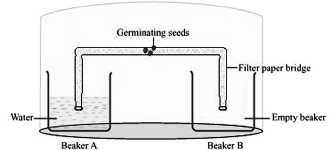
Observation:
The roots of the germinating seeds will grow towards beaker A.
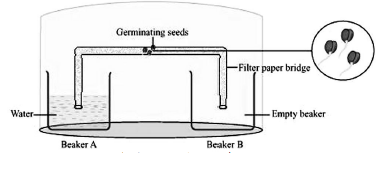
This experiment demonstrates the phenomenon of hydrotropism.
HORMONES IN ANIMALS
The hormones in animals are produced by the endocrine glands, and they too play an important role in control and coordination.
Hormones are chemical substances that control and coordinate activities of living organisms and also their growth. The term hormone was introduced by Bayliss and Starling. Animal hormones do not bring about directional growth depending on environmental cues, but promote controlled growth in various areas to maintain the body design. Thevarious endocrine glands in humans are hypothalamus, pineal gland, pituitary gland, thyroid gland, parathyroid glands, thymus, pancreas, adrenal glands, ovary (in female) and testis (in males).
FEATURES AND FUNCTIONS OF HORMONES:
- They are secreted by the endocrine glands and are called ‘chemical messengers’.
- They are poured directly into blood stream as endocrine glands have no ducts of their own (ductless glands).
- They usually have their effect at sites different from the sites where they are made. They act on specific areas called targetorgans.
- Hormones coordinate body activities and growth
- They are released in minute quantities
ENDOCRINE SYSTEM
The endocrine system is composed of several endocrine glands. A ductless gland is called endocrine gland. Endocrine gland secretes its product directly into the bloodstream. Hormones are produced in the endocrine glands. Hormone is mainly composed of protein. Hormones assist the nervous system in control and coordination. Nerves do not reach to every nook and corner of the body and hence hormones are needed to affect control and coordination in those parts. Moreover, unlike nervous control; hormonal control is somewhat slower.
Different types of endocrine glands present in our body are the pituitary gland, the pineal gland, the hypothalamus, the thyroid, the parathyroid, the thymus, the adrenal gland, the pancreas, the testes and the ovary.
The pituitary gland:
- It is a pea-shaped gland located at the base of the brain.
- It is considered to be master gland as it secretes many hormones to regulate the organs as well as the other glands.
- Different hormones secreted by this gland include Growth hormone, TSH, FSH, LH, ACTH, MSH, Vasopressin and Oxytocin.
The hypothalamus:
- It is a neuro-endocrine part of the brain.
- It links the nervous system and the endocrine system through the pituitary gland.
- Different hormones secreted by this gland include TRH, GnRH, GHRH, CRH, Stomatostatin, Dopamine.
The thyroid gland:
- It is located in the neck, ventral to the larynx.
- It is the one of the largest endocrine glands.
- The principal hormones produced by this gland are triiodothyronine and thyroxine.
- Thyroxine is a hormone that regulates the metabolism of carbohydrates, proteins and fats in the body.
Hyposecretion of thyroxine leads to cretinin in children, and myxoedema in adults.
Hypersecretion of thyroxine leads to exopthalmic goitre in adults. Goitre is caused due to deficiency of iodine in food. Iodine is essential for the synthesis of thyroxine.
Parathyroid glands:
- These are two pairs of small, oval-shaped glands embedded on the dorsal surface of the thyroid gland present in the neck.
- They secrete parathormone. Parathormone helps in regulation of calcium and phosphate ions in the bones and blood.
- Hyposecretion leads to parathyroid tetany and hypersecretion causes osteoporosis.
The adrenal glands:
- These are located above the kidneys and hence are called as suprarenal glands.
- Two regions of the adrenal gland are adrenal cortex and adrenal medulla.
- Adrenal cortex secretes the hormones like cortisol, aldosterone and androgens.
- Adrenal medulla secretes the hormones like adrenaline and noradrenaline.
Adrenaline is also called the “hormone of fight or flight,” or the emergency hormone. It prepares the body to face an emergency condition of physical stress, like danger, anger and excitement.
The pancreas:
- It is located just below the stomach within the curve of the duodenum. It is both exocrine and endocrine in function.
- It secretes hormones such as insulin, glucagon, somatostatin and pancreatic polypeptide.
- Insulin regulates the sugar level in our blood. Insulin secreted in small amounts ncreases the sugar level in our blood which in turn causes a disease called diabetes mellitus.
Gonads:
Two types of gonads present in human beings are female gonads and male gonads.
Female gonads
- A pair of ovaries forms the gonads in female.
- Ovaries are the female sex organs that lie one on either side of the abdominal cavity. Ovaries produce two hormones, namely, oestrogen and progesterone.
- Oestrogen controls the changes that occur during puberty, like feminine voice, soft skin and development in mammary glands.
- Progesterone controls the uterine changes in the menstrual cycle, and helps in the maintenance of pregnancy.
Male gonads
- A pair of testes forms the gonads in males.
- A pair of testes is the male sex organ located in the scrotum, which is outside the abdomen.
- Testes produce the hormone testosterone.
- Testosterone controls the changes, which occur during puberty, like deeper voice, development of penis, facial and body hair.
The pineal gland:
- It is located near the centre of the brain, dorsal to the diencephalon.
- It produces the hormone melatonin.
- Melatonin affects reproductive development, modulation of wake and sleep patterns, and seasonal functions.
The thymus gland:
- It is located in front of the heart, in the upper part of the sternum.
- It produces the hormone thymosine.
- It helps in the maturation of T-lymphocytes.
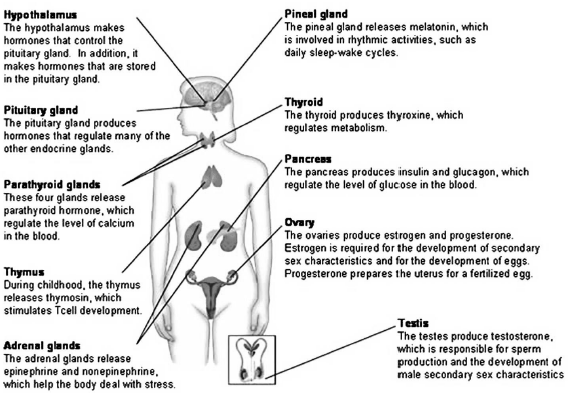
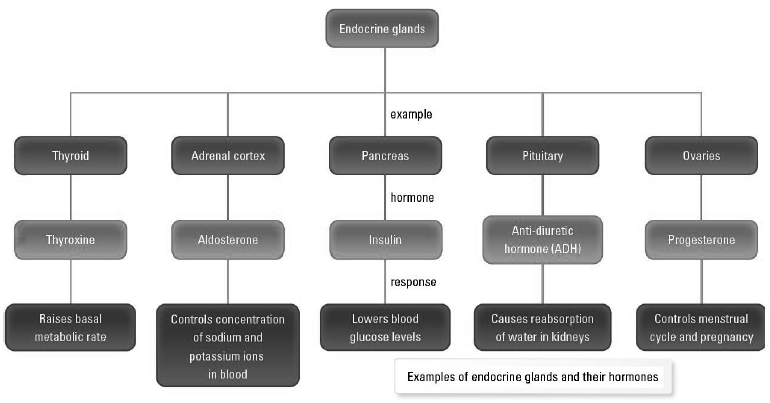
Question. How does chemical coordination take place in animals?
Answer: Chemical coordination takes place in animals with the help of hormones.Hormone is the chemical messenger that regulates the physiological processes in living organisms. It is secreted by glands .The regulation of physiological processes, and control and coordination by hormones comes under the endocrine system. The nervous system along with the endocrine system in our body controls and coordinates the physiological processes.
Question. Why is the use of iodised salt advisable?
Answer: Iodine stimulates the thyroid gland to produce thyroxin hormone. It regulates carbohydrate, fat, and protein metabolism in our body. Deficiency of this hormone results in the enlargement of the thyroid gland. This can lead to goitre, a disease characterized by swollen neck. Therefore, iodised salt is advised for normal functioning of the thyroid gland.
Question. How does our body respond when adrenaline is secreted into the blood?
Answer: Adrenalin is a hormone secreted by the adrenal glands in case of any danger or emergency or any kinds of stress. It is secreted directly into the blood and is transported to different parts of the body.
When secreted in large amounts, it speeds up the heartbeat and hence supplies more oxygen to the muscles. The breathing rate also increases due to contractions of diaphragm and rib muscles. It also increases the blood pressure. All these responses enable the body to deal with any stress or emergency.
Question. Why are some patients of diabetes treated by giving injections of insulin?
Answer: Diabetes is a disease in which the level of sugar in the blood is too high. Insulin, a hormone secreted by the pancreas, helps in regulating the blood sugar levels. This is the reason why diabetic patients are treated by giving injections of insulin.
Question. Which of the following is a plant hormone?
(a) Insulin
(b) Thyroxin
(c) Oestrogen
(d) Cytokinin
Answer: Cytokinin is a plant hormone.
Question. The gap between two neurons is called a
(a) dendrite.
(b) synapse.
(c) axon.
(d) impulse.
Answer: The gap between two neurons is called a synapse.
Question. The brain is responsible for
(a) thinking.
(b) regulating the heart beat.
(c) balancing the body.
(d) all of the above.
Answer: The brain is responsible for thinking, regulating the heart beat and balancing the body.
Question. What is the function of receptors in our body? Think of situations where receptors do not work properly. What problems are likely to arise?
Answer: Receptors are sensory structures (organs/tissues or cells) present all over the body. The receptors are either grouped in case of eye or ear, or scattered in case of skin.
Functions of receptors:
(i) They sense the external stimuli such as heat or pain.
(ii) They also trigger an impulse in the sensory neuron which sends message to the spinal cord.
When the receptors are damaged, the external stimuli transferring signals to the brain are not felt. For example, in the case of damaged receptors, if we accidentally touch any hot object, then our hands might get burnt as damaged receptors cannot perceive the external stimuli of heat and pain.
Question. Draw the structure of a neuron and explain its function.
Answer: Neurons are the functional units of the nervous system. The three main parts of a neuron are axon, dendrite, and cell body.
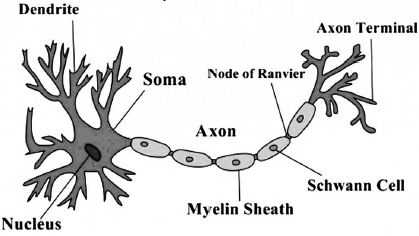
Functions of the three parts of a neuron:
Axon: It conducts messages away from the cell body.
Dendrite: It receives information from axon of another cell and conducts the messages towards the cell body.
Cell body: It contains nucleus, mitochondria, and other organelles. It is mainly concerned with the maintenance and growth.
Question. How does phototropism occur in plants?
Answer: The growth movement in plants in response to light stimulus is known as phototropism. The shoots show positive phototropism and the roots show negative phototropism. This means that the shoots bend towards the source of light whereas the roots bend away from the light source.
Some examples of phototropism are as follows:
(a) The flower head of sunflower is positively phototropic and hence it moves from east to west along with the sun.
(b) The ovary stalk of groundnut is positively phototropic before fertilization and becomes negatively phototropic after fertilization, so that the fruit is formed underground.
Question. Which signals will get disrupted in case of a spinal cord injury?
Answer: The reflex arc connections between the input and output nerves meet in a bundle in the spinal cord. In fact, nerves from all over the body meet in a bundle in the spinal cord on their way to the brain. In case of any injury to the spinal cord, the signals coming from the nerves as well as the signals coming to the receptors will be disrupted.
Question. How does chemical coordination occur in plants?
Answer: In animals, control and coordination occur with the help of nervous system. However, plants do not have a nervous system.
Plants respond to stimuli by showing movements. The growth, development, and responses to the environment in plants is controlled and coordinated by a special class of chemical substances known as hormones. These hormones are produced in one part of the plant body and are translocated to other needy parts. For example, a hormone produced in roots is translocated to other parts when required. The five major types of phytohormone are auxins, gibberellins, cytokinins, abscisic acid, and ethylene. These phytohormones are either growth promoters (such as auxins, gibberellins, cytokinins, and ethylene) or growth inhibitors such as abscisic acid.
Question. What is the need for a system of control and coordination in an organism?
Answer: The maintenance of the body functions in response to changes in the body by working together of various integrated body systems is known as coordination. All the movements that occur in response to stimuli are carefully coordinated and controlled. In animals, the control and coordination movements are provided by nervous and muscular systems. The nervous system sends messages to and away from the brain. The spinal cord plays an important role in the relay of messages. In the absence of this system of control and coordination, our body will not be able to function properly. For example, when we accidentally touch a hot utensil, we immediately withdraw our hand. In the absence of nerve transmission, we will not withdraw our hand and may get burnt.
Question. How are involuntary actions and reflex actions different from each other?
Answer: Involuntary actions cannot be consciously controlled. For example, we cannot consciously control the movement of food in the alimentary canal. These actions are however directly under the control of the brain. On the other hand, the reflex actions such as closing of eyes immediately when bright light is focused show sudden response and do not involve any thinking. This means that unlike involuntary actions, the reflex actions are not under the control of brain.
Question. Compare and contrast nervous and hormonal mechanisms for control and coordination in animals.
Answer:

Question. What is the difference between the manner in which movement takes place in a sensitive plant and the movement in our legs?
Answer:


